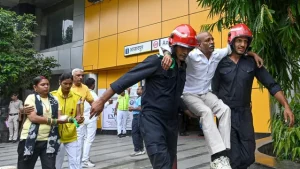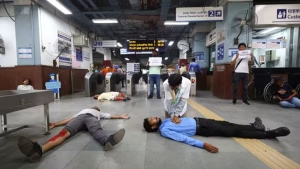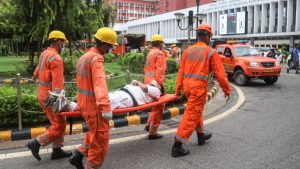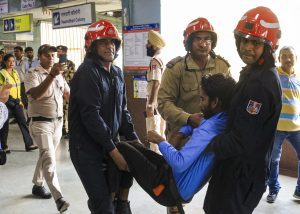New Delhi – The Delhi Disaster Management Authority orchestrated extensive Delhi Earthquake Mock Drills on Friday, testing the capital’s emergency preparedness across 55 strategic locations throughout the city. This large-scale exercise, conducted in collaboration with the National Disaster Management Authority and approximately 20 stakeholder departments, represented one of the most comprehensive disaster preparedness initiatives undertaken in recent years.
The Delhi Earthquake Mock Drills commenced precisely at 9:03 AM, simulating a high-magnitude earthquake scenario that activated emergency response protocols across diverse urban infrastructure. This timing ensured maximum participation from various sectors while testing the effectiveness of coordinated disaster response during peak operational hours.
The scope of these Delhi Earthquake Mock Drills extended beyond simple earthquake simulation, incorporating complex chemical hazard scenarios that could realistically occur following seismic events. This multi-hazard approach reflected sophisticated understanding of cascading disaster effects and the need for comprehensive emergency management strategies.
Extensive Geographic Coverage and Multi-Sector Participation

The Delhi Earthquake Mock Drills encompassed all 11 revenue districts of the National Capital Territory, ensuring comprehensive coverage across diverse urban environments. Participating locations included schools, hospitals, metro stations, industrial zones, and government offices, creating a realistic cross-section of Delhi’s operational infrastructure.
Schools participating in the Delhi Earthquake Mock Drills provided crucial testing opportunities for evacuation procedures involving vulnerable populations. Educational institutions serve as community centers during disasters, making their preparedness essential for broader emergency response effectiveness.
Hospital participation in the Delhi Earthquake Mock Drills tested medical surge capacity, patient evacuation procedures, and continuity of critical care services during seismic events. Healthcare facilities must maintain operations while potentially serving as primary treatment centers for disaster casualties.
Also Read: CBSE Section Expansion Norms 2025: Revolutionary Policy Changes Transform School Admissions
Metro stations included in the Delhi Earthquake Mock Drills addressed unique challenges of underground transportation systems during earthquakes. These facilities present complex evacuation scenarios due to confined spaces, high passenger density, and limited exit routes.
Chemical Hazard Simulation Components

The Delhi Earthquake Mock Drills incorporated specialized chemical disaster simulations in industrial clusters across West, North-East, and South-West Delhi. These scenarios tested response capabilities for secondary hazards that frequently accompany major seismic events in industrial areas.
Industrial zones participating in the Delhi Earthquake Mock Drills provided realistic testing environments for hazardous material containment, evacuation procedures, and specialized rescue operations. Chemical facilities require unique emergency protocols due to potential toxic exposures and environmental contamination risks.
The multi-hazard approach of these Delhi Earthquake Mock Drills reflected sophisticated disaster management understanding, recognizing that major earthquakes often trigger secondary emergencies requiring coordinated response across multiple specialties.
Emergency Response System Assessment
DDMA CEO Krishna Kumar emphasized that the Delhi Earthquake Mock Drills assessed key components of the capital’s disaster management framework. The exercise evaluated incident response systems, emergency operation center functionality, inter-agency coordination mechanisms, and public warning system effectiveness.
The Delhi Earthquake Mock Drills tested the functioning of both state and district emergency operation centers, ensuring seamless communication and coordination between different administrative levels during crisis situations. These centers serve as command and control hubs during actual disasters.
Medical and fire services coordination received particular attention during the Delhi Earthquake Mock Drills, testing rapid deployment capabilities, resource allocation efficiency, and inter-service communication protocols. Emergency medical services and fire departments form the backbone of immediate disaster response.
Operational Deployment and Relief Operations


Staging areas were activated during the Delhi Earthquake Mock Drills for task force deployment, testing the logistics of rapid emergency response team mobilization. These areas serve as coordination points for specialized rescue teams, equipment distribution, and operational planning.
Relief camps were established as part of the Delhi Earthquake Mock Drills to test support systems for displaced persons. These facilities provide temporary shelter, food distribution, medical care, and family reunification services during extended emergency situations.
Mock rescue operations conducted during the Delhi Earthquake Mock Drills involved realistic casualty scenarios, testing extraction techniques, medical triage procedures, and hospital transport coordination. Simulated victims were transported to participating hospitals for treatment evaluation.
Inter-Agency Coordination and Stakeholder Involvement
The Delhi Earthquake Mock Drills involved extensive inter-agency coordination among health services, police, fire departments, Delhi Metro, water board, and civil defense organizations. This multi-agency participation tested communication protocols, resource sharing agreements, and unified command structures.
Each participating department in the Delhi Earthquake Mock Drills brought specialized capabilities and resources, creating opportunities to test integrated response strategies. Effective disaster management requires seamless coordination among diverse organizations with different operational procedures.
Evaluation and Continuous Improvement Framework


Following the Delhi Earthquake Mock Drills, all participating departments will submit comprehensive “after action reports” identifying operational gaps and suggesting improvements to disaster management plans and standard operating procedures. This systematic evaluation process ensures continuous enhancement of emergency preparedness capabilities.
The DDMA has emphasized the importance of regular drills to maintain long-term readiness, building upon lessons learned from these Delhi Earthquake Mock Drills. Periodic exercises ensure skills remain sharp and procedures stay current with evolving best practices.
Building Resilient Response Systems
Kumar described the Delhi Earthquake Mock Drills as a significant step toward building a resilient, scientifically informed disaster response system for the National Capital Territory. This evidence-based approach incorporates lessons learned from global disaster management experiences.
The DDMA expressed gratitude to residents for their cooperation during the simulation, acknowledging that public participation remains essential for effective disaster preparedness and community resilience building throughout Delhi.


